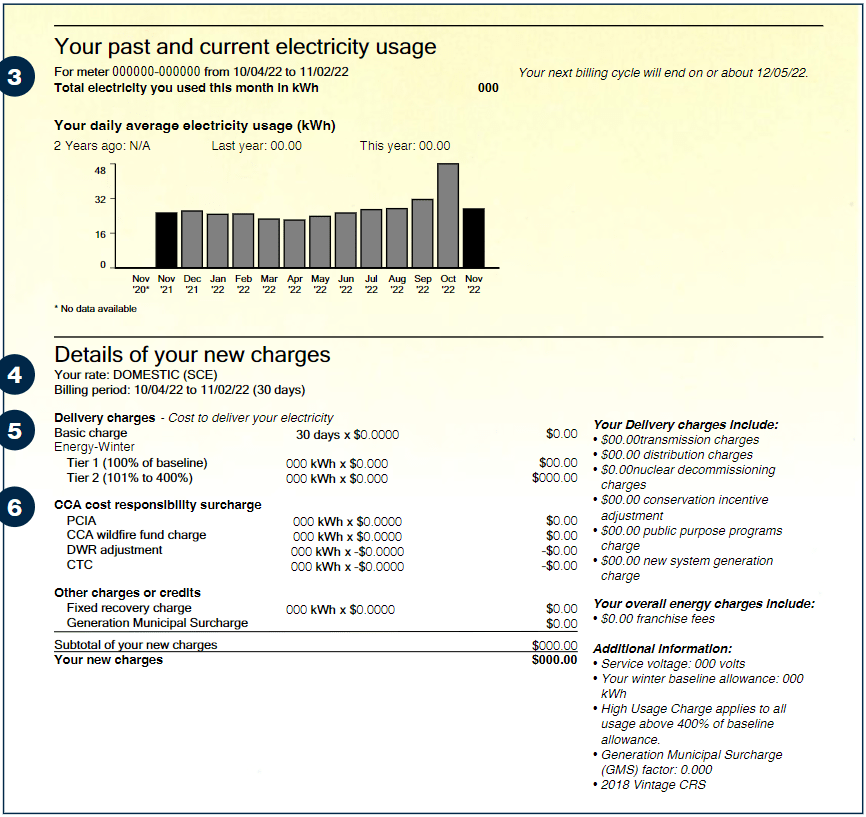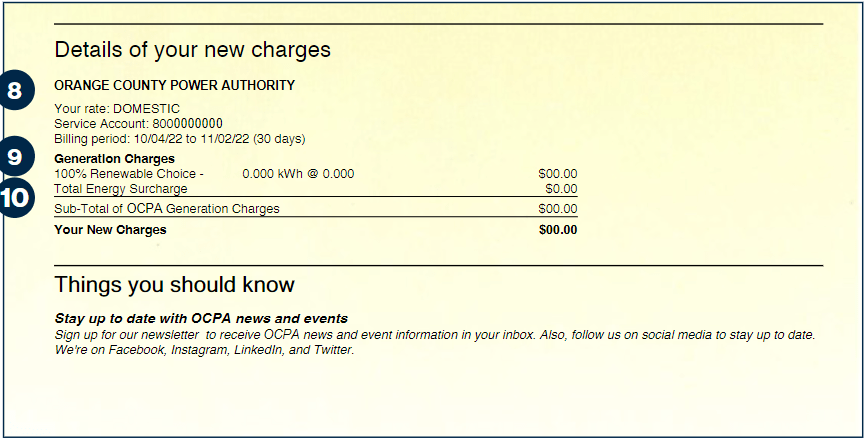Understanding Your Bill
As your community energy provider, Orange County Power Authority (OCPA) strives to keep its service simple.
When it comes to the breakdown of your monthly bill, the household will receive the monthly bill from Southern California Edison (SCE), which includes your SCE charges for electricity delivery followed by your OCPA charges for electricity generation. Note that OCPA is NOT an added or duplicate fee; it simply replaces SCE’s generation charges. This page describes the different charges you may see on your electric bill.
Click here for information about how to read a Net Energy Metering (NEM) bill.
Learn more by hovering over the numbers below.

Your SCE-assigned customer account number identifies your account. Please have your customer account number on hand if you would like to make changes to your OCPA service.
The first line in this section lists your total delivery charges from SCE. The second line lists your total generation charges from OCPA. SCE assigns a separate service account number to track your OCPA charges, but these are NOT added fees – they simply replace supply/generation charges you previously received from SCE.

The amount of energy you used in the billing period, measured in kilowatt-hours (kWh). Your energy usage may change significantly from month to month and year to year depending on weather, appliance use, and other factors. Increased usage is often the reason for larger bills. If you get a larger than normal bill, you can check your usage here (also check usage tiers, #7 below).
In this section, “Your rate” refers to the SCE rate schedule that determines how you are charged for the delivery of electricity. The most common residential rate schedule is DOMESTIC.
SCE’s charges for the delivery of electricity. They include the cost of moving energy from the grid to your home or business and maintaining the electric lines, are paid by all electricity customers, and are exactly the same even if you get your supply/generation from OCPA. Prices may vary by season (Winter and Summer). Around June and October, your bill may reflect usage and charges for both the end of one season and the beginning of the next.
These charges are paid by all electricity customers but they are itemized differently on your bill as an OCPA customer. The DWR Bond Charge1 and CTC (Competition Transition Charge)2 are legacy charges related to the cost of deregulation of the California electricity system in the late 1990s and early 2000s. The PCIA, or Power Charge Indifference Adjustment3, reimburses SCE for above-market energy contracts SCE entered into in the past to serve its customers, including those now served by OCPA. SCE receives these funds. OCPA discounts its generation rates to account for the PCIA to keep our customers’ total bills competitive with SCE. Learn more about OCPA rate options at Residential Rates

For residential customers who are not on Time of Use (TOU) rates, this section indicates how much energy you used during the billing period at each rate tier for your SCE delivery charges. The tier levels are set by state law. Usage under Tier 2 and High Usage are charged at higher prices, which is another reason that high usage can result in an unusually high bill.

In this section, “Your rate” is the OCPA rate schedule that determines how you are charged for electricity supply/generation. If you are on a Time of Use (TOU) rate, the seasons and TOU periods for your OCPA generation charges and your SCE delivery charges are identical.
OCPA’s charge for the generation of electricity. This is NOT an additional charge. It replaces the generation charges that SCE would be collecting if it were your supply/generation provider. This section notes the OCPA rate option currently selected for your account: Basic Choice (44% renewable), Smart Choice (72% renewable), or 100% Renewable Choice (100% renewable). If you would like to make changes to your OCPA rate option, please contact OCPA or visit the website.
This surcharge is collected from all electricity customers statewide to fund clean energy programs and projects including the activities of the California Energy Commission.
The DWR (Department of Water Resources) Bond Charge is a legacy charge to pay off bonds that were issued to rescue the California electricity system from the 2000-2001 energy crisis. It was set to expire in 2021 but was extended for another 15 years to establish a wildfire liability fund that Investor Owned Utilities like Southern California Edison (SCE) can draw upon in the event of a catastrophic event. This charge has been part of SCE customer bills since before Orange County Power Authority. The charges go to the State of California for potential disbursement to the Investor Owned Utilities if necessary. 2. The CTC (Competition Transition Charge) is a legacy charge related to electricity sector deregulation in the late 1990s. This charge provides an accelerated recovery of Investor Owned Utility investments made prior to deregulation. This charge has been part of SCE customer bills since before Orange County Power Authority. These charges go to SCE. 3. Although it is sometimes referred to as an “exit fee,” the PCIA (Power Charge Indifference Adjustment) collects funds to cover above-market energy contract costs that are paid for by all electricity customers, not just those who switched to a Community Choice Aggregator like OCPA. These above-market costs are embedded in SCE’s generation rates for bundled SCE customers; starting next year these costs will be itemized for all customers, regardless of who is your energy supplier. These charges go to SCE. 4. Some customers will see a Utility User Tax. The Utility User Tax (UUT) may be imposed by a city on the consumption of utility services, including (but not limited to) electricity, gas, water, sewer, telephone (including cell phone and long distance), sanitation and cable television. This tax is levied by the city, collected by the utility as part of its regular billing procedure, and then remitted to the city.

